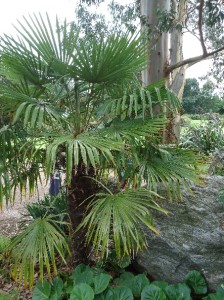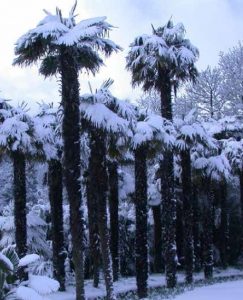Trachycarpus fortune
This hardy oriental palm survives not only the Edinburgh climate, but in the far north west of Scotland. At Scourie in Sutherland a specimen is growing near the hotel and claims to be the world’s northernmost palm tree growing out-of-doors.
In the wild it occurs, often at altitude, across central and southern China, extending into Burma and northern India, where it copes with cool moist summers and even modest snow cover in winter. The dense fibre tufts that cloak the stem have been harvested for thousands of years, to exploit their robust strength in the making of strong rope, sacking and other coarse cloths.
What’s in a name?
Its crowning spray of long-stalked, fan leaves inspires the alternative popular name – the Chinese windmill palm. The first western botanist to observe this species was Berwickshire plant hunter, Robert Fortune (1812–1880), who found cultivated specimens on Zhoushan (Chusan) Island. When the plant was formally described and named it became T. fortunei, in his honour.
Robert Fortune: Scottish plant hunter
Fortune worked for a time at the RBGE, before moving to the London Horticultural Society at Chiswick. In 1843 they dispatched him to China to seek out and collect seeds and specimens of ornamentals and useful plants that could be cultivated back in Britain. He subsequently returned in 1848, at the behest of the East India Company, to seek out the finest varieties of Chinese tea plants for potential cultivation in India – perhaps the first example of industrial espionage involving plants!
This is the final palm on The World of Palms Glasshouse Trail Click here to return to the first point of the trail



1 Comment
1 Pingback